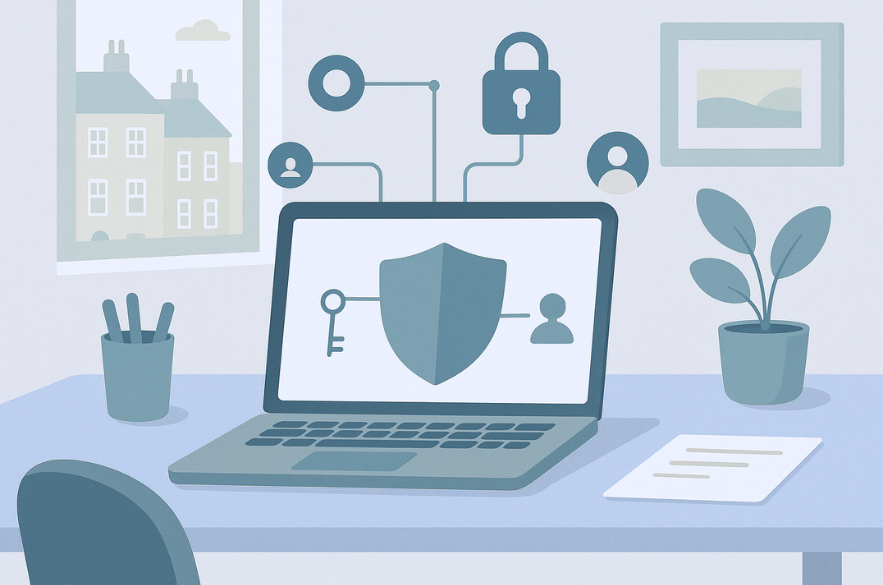For many small and medium-sized businesses (SMBs) in the UK, investing in endpoint protection; antivirus, host intrusion prevention, device management, still feels like the “core” cybersecurity decision. After all, nearly every malware campaign starts with a device. But in today’s threat environment, endpoint protection alone is no longer sufficient. Attackers routinely bypass devices, exploit identity and cloud layers, and move laterally once inside. In 2025 the defence perimeter is not just the endpoint, it is identity, device posture, network context and continuous verification.
Why Endpoint Protection Alone Falls Short
1. Endpoints are only one piece of the attack surface
Endpoint protection focuses on devices like desktops, laptops, mobile devices. Yet attacks increasingly exploit other vectors: cloud apps, identity credentials, remote access, lateral movement inside the network, IoT devices and unmanaged devices. For example, an industry test by SE Labs showed that many “endpoint protection” products for SMBs were challenged by real-world attack simulations of sophisticated adversaries.
2. Identity is the new perimeter
While devices matter, identity matters more. If user credentials are compromised, a device may pass endpoint checks but still allow an attacker into critical systems. A 2024 CyberArk report found that 79% of cybersecurity professionals said identity management is the most critical principle for Zero Trust initiatives.
3. Traditional endpoint defences cannot prevent lateral movement
Even if the device is protected, once inside the network attackers often move laterally and escalate privileges. Traditional endpoint security often fails to prevent or detect this. One security commentary noted: “Endpoint protection solutions are not enough to protect against human error or insider threats.”
4. The threat environment has changed
The growth of remote/hybrid work, BYOD, cloud services and edge computing means endpoints are no longer located purely inside a corporate network. Microsoft’s guidance on Zero Trust shows that endpoint security must be enforced regardless of network location, cloud or home WiFi.
What a Modern Security Strategy Must Include
Layered security: endpoint plus identity plus network plus cloud
Think of endpoint protection as the first line, not the only line. To protect today you also need:
- Identity and access management (IAM) including MFA, conditional access, least-privilege.
- Device posture checks, compliance assurance, managed/unmanaged device handling.
- Network segmentation and micro-segmentation so that a compromised device cannot access everything.
- Continuous monitoring and real-time analytics (behavioural, anomaly detection).
- Cloud and SaaS controls; because many SMBs use cloud apps that endpoints connect to but may not protect themselves.
Zero Trust as the strategic framework
“Never trust, always verify” is the mantra of Zero Trust. According to research, organisations using Zero Trust frameworks reported reduced security incidents: one study found 83% of organisations saw fewer incidents. For SMBs, Zero Trust means verifying identity, device health, user behaviour, application context, not simply trusting the device because it is “inside”.

Identity-First Protection
Identity rather than device is becoming the primary battleground. For SMBs this means:
- Multi-Factor Authentication (MFA) for all users
- Conditional access (device meets health, location, network check)
- Role-based access and least-privilege
- Monitoring of identity behaviour (login anomalies, privileged account hops)
Why This Matters for UK SMBs
- SMBs are increasingly targeted: recent data indicates 94% of SMBs faced at least one cyberattack in the past year.
- Many SMBs believe endpoint protection alone is sufficient because it’s familiar, but the attack vectors they face now extend beyond devices.
- Cyber insurers and customers increasingly assess identity and segmentation controls. Without layered security your exposure remains high despite endpoint tools.
Actionable Steps for UK SMBs
Step 1: Review your endpoint protection maturity
Ask: Do we only protect device breaches? Do we monitor for user credential misuse? Are endpoints always compliant and patched? If yes, good. But also check: does the device trust model assume network location or status? If yes, you have gaps.
Step 2: Implement identity and access basics
- Enforce MFA for all users including third-party vendors
- Implement least-privilege access; users only get what they need
- Establish conditional access: device health, location, network type must pass before access is granted
- Microsoft’s SMB guidance emphasises this: “Verify explicitly, use least privilege, assume breach”.
Step 3: Ensure devices meet posture checks
Make sure that devices connecting to your network or cloud apps are compliant: OS updates, antivirus, encryption, no jailbroken status, no unmanaged apps. This extends endpoint protection into posture management.
Step 4: Introduce network segmentation and monitoring
Even with good endpoint and identity controls, if all devices share one flat network you risk lateral spread of threats. Micro-segmentation helps. Real-time monitoring catches abnormal behaviour early.
Step 5: Build an incident-ready culture

No protection is perfect. Your strategy must assume a breach will happen. Shorter mean-time-to-detect (MTTD) and mean-time-to-respond (MTTR) are critical. Using layered defences reduces blast radius and improves resilience.
Key Takeaways
- Endpoint protection remains necessary, but it’s not sufficient.
- The most common way attackers succeed today is via identity compromise, misuse of credentials, lateral movement.
- Zero Trust and identity-first models give organisations a framework to protect beyond devices.
- SMBs that rely solely on endpoint tools are exposed despite their investment.
- For UK SMBs, adopting layered security (endpoint + identity + network segmentation + monitoring) is essential, not optional.
At I-Net Software Solutions, we specialise in helping UK SMBs evolve from device-centric protection to identity-first, layered security postures. If you’re relying only on endpoint antimalware and thinking “we’re safe”, it’s time to rethink the strategy. We can help you assess your current controls, identify gaps in identity and access, and build a realistic roadmap for Zero Trust adoption.
→ Book your Security Readiness Audit
Recommended Next Insight
How to Fix High Bounce Rates: What Your Visitors Are Actually Telling You
